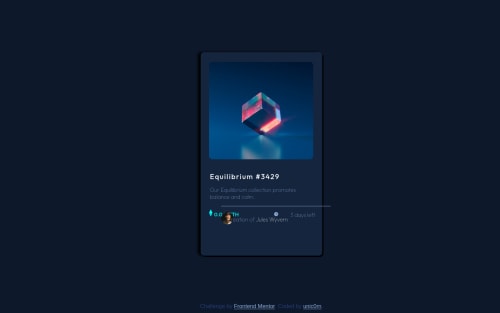CSS HTML

Solution retrospective
- still don't know how to make such a soft shadow as on original example, i searched everywhere, couldn't find it :(
- Hard for me to put <p> and icon or image in 1 line together. Somehow i did it but not sure if i did right.
- I couldn't make a white border on avatar picture. I tried "border-width" with "border-color" but it didn't work.
Please help me if you know how to do it. Thank you!
Please log in to post a comment
Log in with GitHubCommunity feedback
- @KTrick01
Hi Kate! You can change the blur of the shadow adding a third value like this
box-shadow: 4px 4px 50px black. About the border of the avatar, first you should use this propertyborder-radius: 50%;this will make square images become "circular", then you can useborder: 1px solid whitefor the border. I hope that it helps you!Marked as helpful - @realsale
Yo! Kate,
First of all congrats submitting your solution, It wasn't bad at all.
Regarding to your question:
1 To make a
shadowlooks like agradientorfadingsame as the background, I use the originalbackground-colorand adds three layers of it with differentsizesandlightnessusing thehsl.component { box-shadow: 0 0 45px hsl(217deg 54% 11%), // largest layer, same color and lightness 0 0 35px hsl(217deg 54% 9%), // middle layer, same color with decrease lightness 0 0 20px hsl(217deg 54% 6%) // inner layer, same color and the darkest }2 There's a couple of way place an image and a text content together, One way is using
flex, Settingdisplayproperty toflexallows you to use other flex container properties e.g.justify-content|align-itemsetc. that can be used to manipulate and controlsflex-items(children)// markup <div class="tag"> <img src="./some/path" alt="foo" /> <p class="tag__details">Foo bar</p> </div> // style .tag {display: flex; align-items: center;} .tag__details{margin-left: 6px;}3 Make sure you set your image dimension length equal both in
widthandheight, then set theborderandborder-radius: 50%; - @unic0rnKate
Please someone explain to me why on the web everything looks good and on its place but when i post here it looks like everything is flying around? what i do wrong.......................? Maybe the way I’m moving elements is not right? I searched all google and cannot find any answers. Please help me, thank you!
Join our Discord community
Join thousands of Frontend Mentor community members taking the challenges, sharing resources, helping each other, and chatting about all things front-end!
Join our Discord